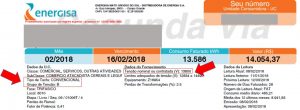Electric energy consumers can be classified into two groups: A or B. Group A (high voltage) is made up of UCs (consumer units) that receive electrical energy at a voltage equal to or greater than 2.3 kV or are served from underground distribution system.
Large industries and large commercial establishments generally fall into this group.
Group B (low voltage) is characterized by UCs served at voltages lower than 2.3 kV, generally with a monomial tariff, proportional to consumption only, there is no demand charge. This category generally includes residences, small industries and small commercial establishments.
REN 414 (Normative Resolution No. 414/2010), which deals with the general conditions of electrical energy supply, determines the criteria for a UC to be classified as group A or group B, which are:
- Group B: UCs served on the overhead network, when the installed load is equal to or less than 75 kW;
- A group: CUs served via an underground network, or overhead networks with an installed load greater than 75 kW (must contract a minimum demand of 30 kW).
When a photovoltaic system is installed in a group A consumer unit, energy compensation will only occur for the portion of the energy consumed, always paying for the billable demand, regardless of the amount of energy generated.
Read too
The same REN 414 provides that a group A consumer unit may choose to be billed as group B (without having to pay the billable demand), as long as it meets at least one of the criteria below:
- Have access to energy through transformers whose sum of nominal powers is equal to or less than 112.5 kVA;
- Be located in a vacation or tourism area whose main activity is the operation of hotel or inn services, regardless of the total nominal power of the transformers. Only those officially recognized as a seaside, hydromineral, climatic or tourist resort are considered a summer or tourism area;
- Be a permanent installation for the practice of sporting activities or agricultural exhibition parks, with an installed load of reflectors equal to or greater than 2/3 (two thirds) of the total installed load;
- Be classified as a Rural Electrification Cooperative, with the sum of the nominal powers of the transformers equal to or less than 1,125 kVA.
If the option for billing as group B is made, there will be no need for physical changes to the facilities, and the consumer unit continues to be served at high voltage, from its private distribution transformers.
The change will only occur in the way this consumer unit is charged for energy, with a monomial tariff, not paying for billable demand.
For consumer units that have a photovoltaic generator installed, such a change, when possible, increases its profitability, as this customer will no longer pay for the billable demand, being able to reduce the energy bill to the minimum cost of availability.

















2 Responses
Caro Bruno
Estou retomando os estudos da energia solar fotovoltaica e gostaria de manter um diálogo em prol destes assuntos técnicos.
Sou oriundo da UFSC, em Florianópolis, trabalho na CGT ELETROSUL ELETROBRAS, participante do COBEI no que tange aos grupos de trabalho do TC88 e atuante na Área de Energia Eólica e Solar. Permaneço à disposição também pelo telefone (whatsApp) (48)999528845.
Hello Bruno, this article is very good, congratulations!!! In this regard, and considering the FREE ENERGY MARKET, what will consumers be classified as A and B? As the supply of clean energy will be guaranteed, if they opt for this modality and possible savings of up to how much, there will be scaling. In a didactic way, as you did in the article above, it is possible to explain it to all of us, thank you very much.